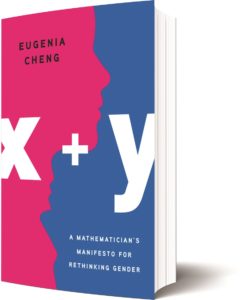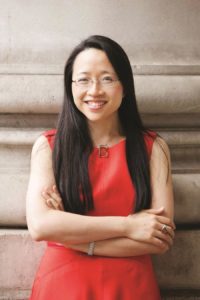Watch a video clip of mathematician Eugenia Cheng making puff pastry with Stephen Colbert, and you’ll quickly appreciate why her students at the Art Institute of Chicago surely consider themselves lucky. As she engages Colbert in verbal and physical swordplay — bashing butter with a rolling pin — Cheng gets him to experience the power of exponentials by making a mille feuille. She is funny. And she makes math fun.

Cheng stepped away from the conventional life of a tenured scholar at the University of Sheffield in the U.K. to connect with popular audiences. Her previous books include The Art of Logic in an Illogical World, Beyond Infinity: An Expedition to the Outer Limits of Mathematics, and How to Bake p: An Edible Exploration of the Mathematics of Mathematics (in which each chapter begins with a recipe — for pie, of course). Given her current career, it’s no surprise that in her latest book, x + y: A Mathematician’s Manifesto for Rethinking Gender, Cheng uses wit and playfulness to explain why and how to be done with attitudes she argues perpetuate inequality and harm us all.
Cheng divides her manifesto into two parts, “Gendered Thinking” and “Ungendered Thinking.” She includes an introduction and postscript, the latter written in the first week of the lockdown this past March. She ends with an appendix containing hypothetical conversational ripostes to illustrate how readers might employ what they’ve learned in the book. If, for instance, a sexist co-worker tells you, “One day you’ll learn,” you might be tempted to say, “One day you’ll retire.” Better, she suggests, would be to ask, “What do you think I’ll learn?”
In “Gendered Thinking,” Cheng uses math to investigate problems she identifies with feminism and gender equality. She finds these concepts needlessly divisive because they insist either that men be more like women or that women be more like men. She takes particular umbrage at Facebook COO Sheryl Sandberg’s suggestion that women “lean in” to succeed. By “leaning in,” some women help each other to behave like men, she writes, but they don’t change the gendered paradigm or definition of individual success.
Math can be useful in moving beyond such divisions, Cheng writes, because it “illuminates deep structures built by ideas … often hidden in their complexity.” Category theory, Cheng’s field, helps spot patterns, identify networks, and express them as abstractions, which are, at their simplest, equations. It’s entertaining to watch Cheng illustrate her points with algebra, graphs, and flow charts to underscore her conviction that it’s time to get rid of gender altogether.
In “Ungendered Thinking,” Cheng explores her own terminology, which she links to character. Using different language, she reasons, we move away from gender and towards a fairer, more inclusive world. She writes that her goal is to explain “how to stop perpetuating subtler forms of systemic bias that favor men by favoring — for no good reason — characteristics associated with men.”
Cheng’s chosen words are “ingressive” and “congressive.” She uses these words to separate behavioral characteristics into two groups. Those who behave in “ingressive ways” privilege the self over the community and are “more competitive and adversarial than collaborative.” By comparison, those Cheng describes as “congressive” behave in ways that focus on “society and community over self” and emphasize “interdependence and interconnectedness,” collaboration, and cautiously slow thinking. Taking aim at entrepreneurs and prize-winning scientists, Cheng explains why collaboration and extensive safety nets are as important, if not more so, than aggressive risk-taking and competition.

In the chapters that follow, Cheng provides examples of a more “congressive” world. Several of these chapters are weaker than previous sections and can be repetitive. The parts I found most interesting applied Cheng’s concepts to teaching and research. Rather than rewarding students who are fast and can provide right answers, Cheng says, teachers can emphasize collaboration, contribution to the group, depth, and curiosity. Students in such classrooms understand that “nobody is trying to win but everyone is trying to make sure the group is making progress and learning.” To encourage “congressive” behaviors, teachers can validate students who help others and who can create and improve. When it comes to academic scholarship, emphasis can be on peer-reviewing methodology rather than supposedly path-breaking results. And the academy itself would be vastly more “congressive” and inclusive were it to value teaching, mentoring, outreach, and public engagement — not just getting grants and winning prizes.
Cheng acknowledges that her manifesto to rethink gender might strike others as “a naively utopian dream.” But, she writes, given that we are all trying to find our way through a pandemic, we need some better strategies for leadership. It is not possible, for example, to “outposture a virus.” She hopes by the time readers encounter x + y, the pandemic “will all be over; I certainly hope so.” Six months in, readers still need hope. Perhaps rating presidential candidates on their “congressivity” will pave the way for a better way forward.



